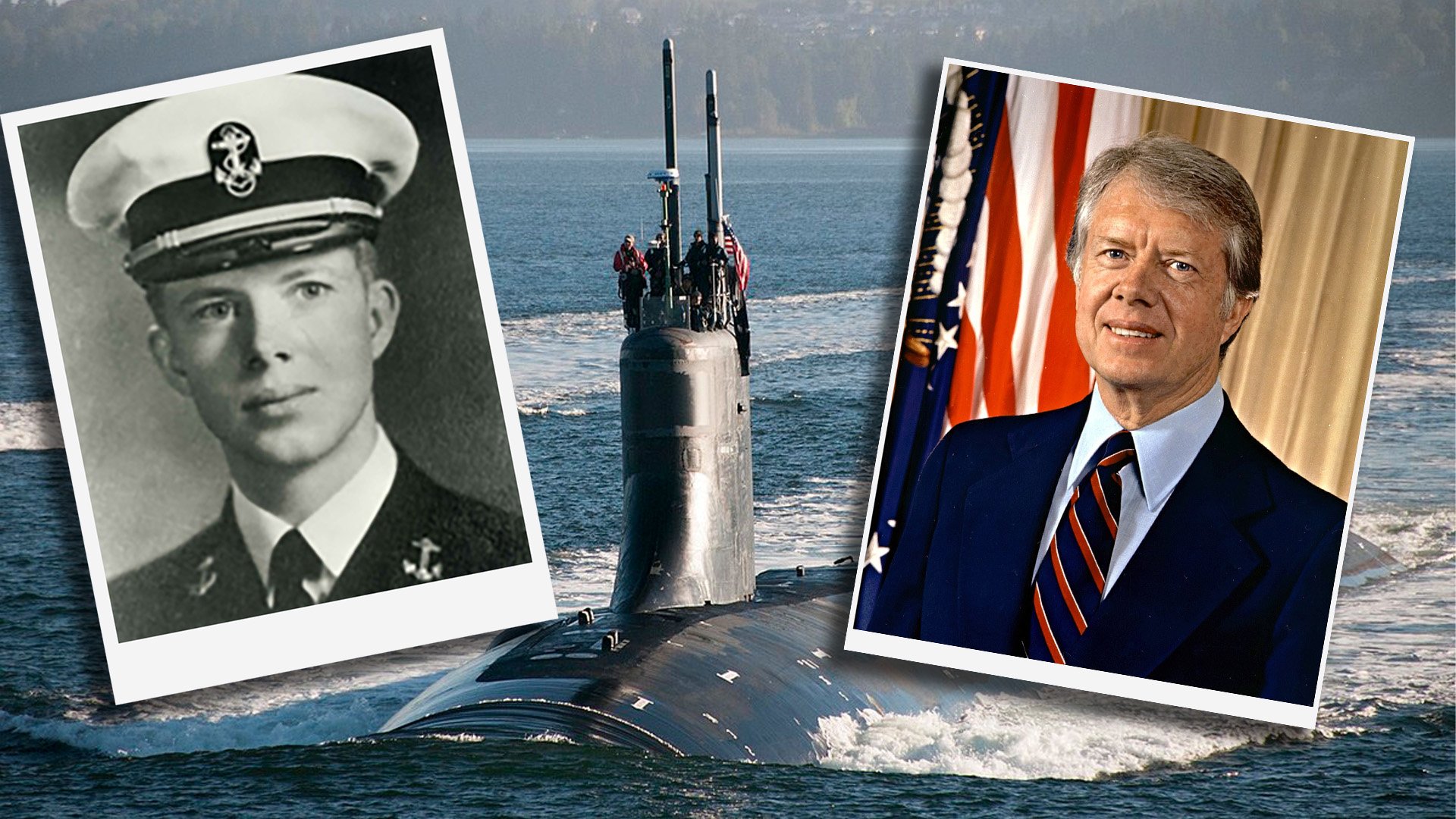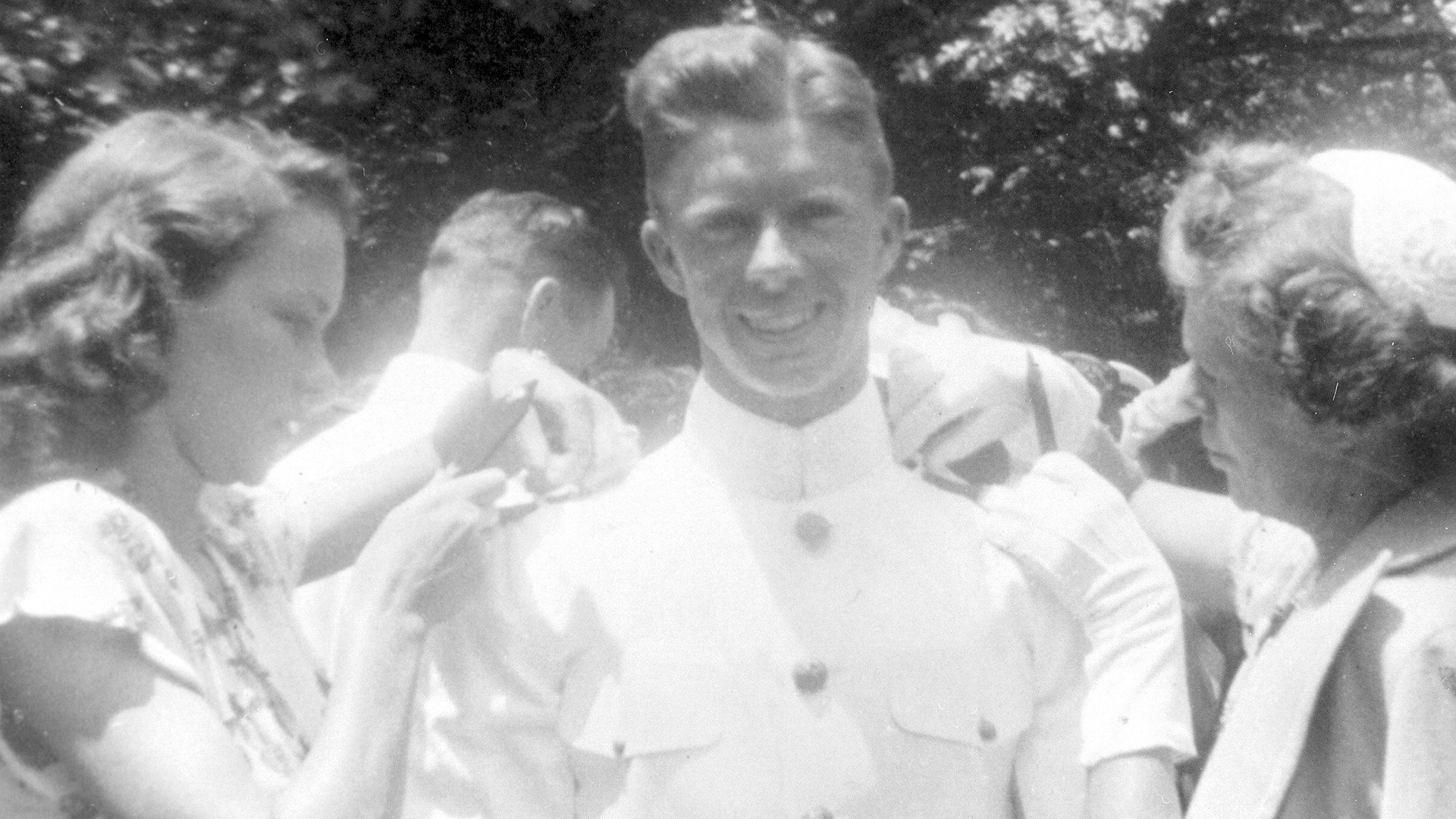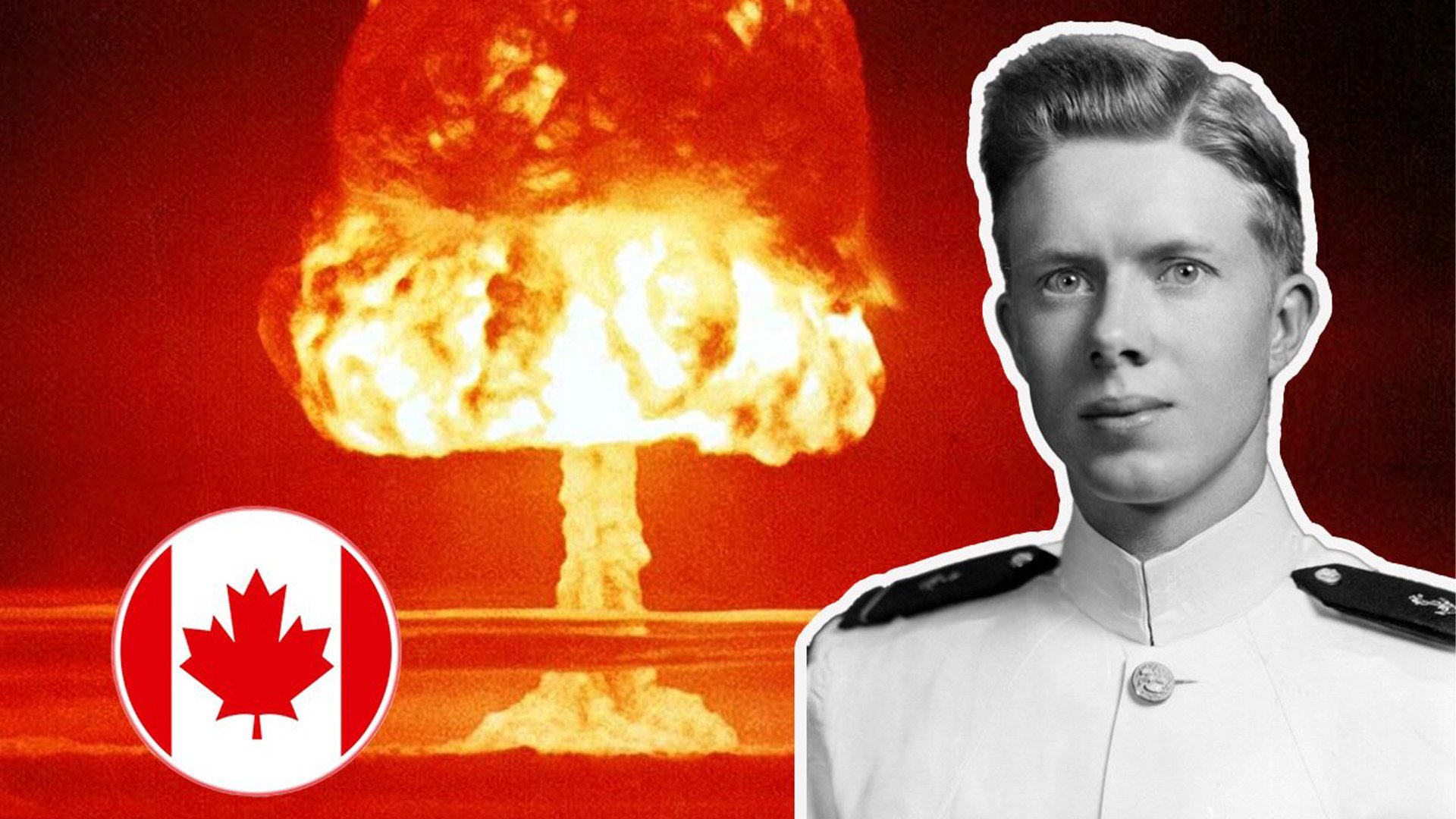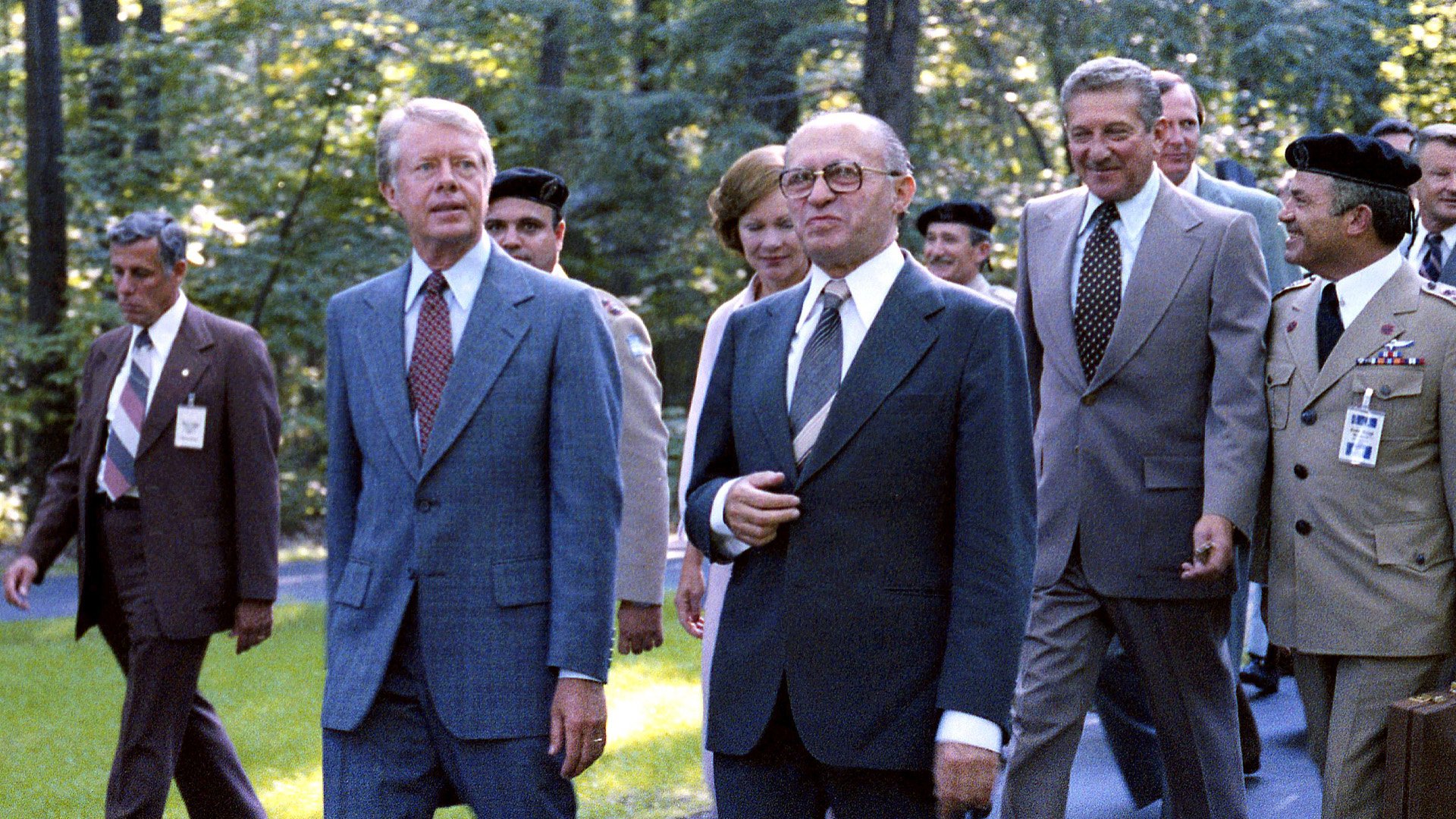From the Silent Service to the Presidency: The Life of Jimmy Carter

Jimmy Carter served as a submarine officer in the US Navy before becoming the 39th president of the United States. Composite by Matt Fratus/Coffee or Die.
Much of America’s modern military muscle began with Jimmy Carter.
As a Navy officer and later as president, Carter was a key figure in two military revolutions: the Navy’s post-World War II reinvention as a modern “nuclear navy,” and the post-Vietnam rise of special operations forces that today are the face of the US military around the globe.
Carter entered the Navy a year too late to see combat in World War II but was on the front row for the service’s postwar reinvention as a nuclear-powered, forward-deployed fleet.
Later, as president, he gave the go-ahead for Operation Eagle Claw, a daredevil raid aimed at rescuing US hostages deep inside Iran. The failed raid was the first major combat operation for Delta Force, the Army’s premier hostage rescue team, and laid the path ahead for joint special operations of the future. And by giving the green light to the operation, and defending it when it failed, Carter put the US on the path toward relying on small teams of special operators for complex operations too sensitive for large conventional forces.
Though 31 US presidents came to their office with military experience, Carter was one of just a handful to serve at sea, and the only one in the “Silent Service” of submarines.
Related: Why the Canteen Persevered in the Age of the CamelBak
Silent Service in the Nuclear Navy

Jimmy Carter with Rosalynn Smith and his mother, Lillian Carter, at his graduation from the United States Naval Academy in Annapolis, Maryland, June 5, 1946. Wikimedia Commons photo.
Jimmy Carter was born on Oct. 1, 1924, and raised on his family’s peanut farm in Plains, Georgia. He was the first family member on his dad’s side to graduate high school. According to one famous anecdote, Carter just missed being named valedictorian of his 26-member graduating class after his teenage decision to play hooky and drive a hot rod to see a movie.
He spent World War II enrolled at the US Naval Academy, graduating in the class of 1946. He was commissioned as an ensign that same year and completed two tours with the battleships Wyoming and Mississippi.
In 1948, Carter began training for the “Silent Service” in New London, Connecticut. The Silent Service was a nickname for the submarine fleet serving during World War II, based on the sensitivity and secrecy of its operations, along with the need for subs to run silently underwater to avoid detection. He served on the Pomfret, a Balao-class electric-diesel propulsion submarine, then was given an assignment that would change his life.
According to the US Naval History & Heritage Command, Carter was interviewed and selected by then-Capt. Hyman G. Rickover for a new program to create nuclear-powered submarines.
Related: A Mysterious Bunker, Secret Rooms, and a Ghost: Myths of the Pentagon
He Once Risked His Life To Rescue Canada

Lt. Jimmy Carter was hand-picked to lead a team during the 1952 meltdown of a nuclear reactor in Canada. Composite by Matt Fratus/Coffee or Die.
On Dec. 12, 1952, an experimental nuclear reactor at Chalk River in northern Ontario, Canada, suffered a partial meltdown that sent hundreds of thousands of gallons of radioactive water into the reactor’s core. Carter, then a lieutenant serving under Rickover to develop nuclear propulsion systems for the USS Seawolf submarine, was sent to clean up the mess. He led a team of 22 other experts with clearance to enter a nuclear power plant.
On-site, to practice their repair techniques, the team set up a full-scale mock-up of a nuclear reactor on a nearby tennis court. Splitting the team into groups of three, Carter would time the groups as they ran to the training reactor with wrenches, knocking off as many nuts and bolts as possible. Wearing white protective clothing, each team had only 90 seconds to clean the reactor before their exposure to the radiation became too high.
Carter later described the final operation.
“Finally when we went down into the reactor itself, which was extremely radioactive, then we would dash in there as quickly as we could and take off as many bolts as we could, the same bolts we had just been practicing on,” Carter wrote, according to CNN. “Each time our men managed to remove a bolt or fitting from the core, the equivalent piece was removed on the mock-up.”
After a successful cleanup, Carter had radioactivity in his urine for about six months. “They let us get probably a thousand times more radiation than they would now,” Carter said in 2008. “It was in the early stages and they didn’t know.”
Carter’s experience with the reactor would mold US policy during the Cold War concerning nuclear and nonproliferation issues at large. In 1953, Carter resigned from the Navy after his dad died of cancer. He left his childhood dream behind to tend to his family’s interests, including running the operations of their peanut farm.
Related: The Fascinating History Behind the US President’s Nuclear Football
Carter Won a Nobel Peace Prize, but Not During His Presidency

President Jimmy Carter, Israeli Prime Minister Menachem Begin, and US national security advisor Zbigniew Brzezinski in September 1978. Carter’s role in mediating a peace deal between Israel and Egypt should have been enough to earn him the Nobel Peace Prize. He would earn the medal later in life for his humanitarian work. Wikimedia Commons photo.
Carter entered the world of politics shortly after his seven-year stint in the Navy. In 1962, he was elected to the Georgia State Senate and served two terms. He then ran for governor twice, winning on his second try in 1970, and announced his candidacy for president in 1974. The Georgia Democrat was elected as the 39th president of the United States, his story as a naval officer and country farmer resonating with voters in the wake of Nixon-era political scandals.
The high point of Carter’s presidency on the international stage was his successful negotiation of a peace agreement between Egypt and Israel in 1978. The Norwegian Nobel Institute, which oversees the Nobel Peace Prize, later said Carter was snubbed for the prize shared by Anwar Sadat and Menachem Begin because he had not been nominated in time.
Carter’s presidency wasn’t without its critics. His failed diplomacy efforts during the Iranian hostage crisis put him under a microscope during the tumultuous affair. As a result, he served just one term between 1977 and 1981, losing to California Republican Ronald Reagan.
Carter established the Carter Center in 1982. According to the Jimmy Carter Library & Museum, he remained undeterred in his commitment to serving others. He led teams in observations of more than 100 elections in 39 countries to ensure democracy, fought to eradicate Guinea worm disease, and promoted peaceful resolutions across Africa, the Middle East, and elsewhere. He also personally built homes with Habitat for Humanity for over 35 years. In 2002, after decades dedicated to these humanitarian endeavors, Carter received the Nobel Peace Prize.
Related: How Billionaire Aviator Howard Hughes Helped the CIA Steal a Soviet Submarine
Rather Than a Carrier, the Navy Named a Submarine After Carter

The Seawolf-class fast-attack submarine USS Jimmy Carter (SSN 23) transits the Hood Canal as the boat returns home to Naval Base Kitsap-Bangor on Sept. 11, 2017. Jimmy Carter is the last and most advanced of the Seawolf-class attack submarines, which are all homeported at Naval Base Kitsap. Wikimedia Commons photo.
Carter’s work developing nuclear propulsion systems for the USS Seawolf submarine warranted recognition too. Carter would be honored by the US Navy as the namesake for a Seawolf-class nuclear-powered fast-attack submarine. The names of eight presidents are currently on US aircraft carriers, including those of the man Carter replaced in the office, Gerald Ford; and the man who replaced him, Ronald Reagan. But the Navy honored Carter in the best way it could, naming a nuclear submarine after him.
The USS Jimmy Carter entered service in 2005. A Seawolf-class submarine, it’s designed to hunt other submarines and warships along with launching undersea drones and Navy SEALs. Its sensitive missions rarely receive any notoriety beyond vaguely worded award citations.
One such instance occurred in 2013. The USS Jimmy Carter departed from its home base in Bangor, Washington, and less than two months later resurfaced in Pearl Harbor, Hawaii, for repairs. According to The National Interest, the submarine had participated in a top-secret operation called Mission 7. The clandestine mission earned the crew a Presidential Unit Citation, often awarded to units that exhibit “extraordinary heroism in action against an armed enemy.”
Read Next: These 10 US Presidents Were Military Heroes Before Politics

Matt Fratus is a history staff writer for Coffee or Die. He prides himself on uncovering the most fascinating tales of history by sharing them through any means of engaging storytelling. He writes for his micro-blog @LateNightHistory on Instagram, where he shares the story behind the image. He is also the host of the Late Night History podcast. When not writing about history, Matt enjoys volunteering for One More Wave and rooting for Boston sports teams.
BRCC and Bad Moon Print Press team up for an exclusive, limited-edition T-shirt design!
BRCC partners with Team Room Design for an exclusive T-shirt release!
Thirty Seconds Out has partnered with BRCC for an exclusive shirt design invoking the God of Winter.
Lucas O'Hara of Grizzly Forge has teamed up with BRCC for a badass, exclusive Shirt Club T-shirt design featuring his most popular knife and tiomahawk.
Coffee or Die sits down with one of the graphic designers behind Black Rifle Coffee's signature look and vibe.
Biden will award the Medal of Honor to a Vietnam War Army helicopter pilot who risked his life to save a reconnaissance team from almost certain death.
Ever wonder how much Jack Mandaville would f*ck sh*t up if he went back in time? The American Revolution didn't even see him coming.
A nearly 200-year-old West Point time capsule that at first appeared to yield little more than dust contains hidden treasure, the US Military Academy said.












